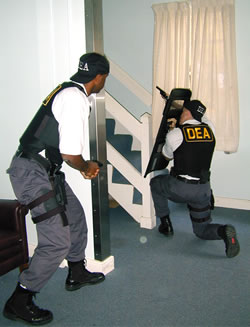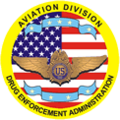Drug Enforcement Administration
The Drug Enforcement Administration (DEA) is a law enforcement agency that works for the United States Department of Justice that enforces the United States drug laws. The DEA is the agency with the most responsiblility for drug enforcement in the U.S. and also shares its responsibilities with the Federal Bureau of Investigation. It also has complete responsibility (duty to do something) for U.S. drug enforcement investigations in other countries.
| Drug Enforcement Administration | |
| Abbreviation | DEA |
| Logo of the Drug Enforcement Administration. | |
| Badge of the Drug Enforcement Administration. | |
| Agency Overview | |
|---|---|
| Formed | 1973, July 1 |
| Preceding agencies | |
| Employees | 10,891 (2006) |
| Annual Budget | $2.415 billion USD (2006) |
| Legal personality | Governmental agency |
| Jurisdictional Structure | |
| Federal agency | United States |
| General nature |
|
| Operational Structure | |
| Headquarters | Arlington, Virginia |
| Special agents | 5,500+ |
| Elected officer responsible | Eric Holder, Attorney General |
| Agency executives |
|
| Parent agency | United States Department of Justice |
| Website | |
| http://www.usdoj.gov/dea/ | |
History
The Drug Enforcement Administration was created on 1 July 1973, by Reorganization Plan No. 2 of 1973, signed by President Richard Nixon on 28 March 1973.[1] It suggested a single federal agency to enforce the federal drug laws as well as to join together and to organize the government's drug control efforts.
In 1999, the DEA opened the Drug Enforcement Administration Museum in Arlington, Virginia. In February 2003, the DEA started a Digital Evidence Laboratory in its Office of Forensic Sciences.[2]
Organization
The DEA is run by an Administrator of Drug Enforcement who is given the job by the President of the United States and confirmed by the U.S. Senate. The Administrator's direct boss is the Attorney General through the Deputy Attorney General.[3] It has its own training centre called the DEA Academy on the United States Marine Corps base at Quantico, Virginia with the FBI Academy. It has 21 domestic divisions inside the U.S. with 227 field offices and 86 foreign offices in 62 countries.[4] With a budget of over 2.415 billion U.S. dollars, the DEA employs over 10,800 people, including over 5,500 Special agents.
Narcotics registration
The DEA has a system in place which allows doctors and other people, such as dentists, physician assistants, and nurse practitioners, to prescribe medicines, researchers and manufacturers access to "Schedule I" drugs, as well as Schedules 2, 3, 4 and 5.
Drug Enforcement Administration Media
Map of the 21 DEA domestic field divisions: 1. Chicago, 2. Detroit, 3. Atlanta, 4. Dallas, 5. Denver, 6. Boston, 7. El Paso, 8. Houston, 9. Los Angeles, 10. Miami, 11. Newark, 12. New Orleans, 13. New York, 14. Philadelphia, 15. Phoenix, 16. San Diego, 17. San Francisco, 18. Seattle, 19. St. Louis, 20. Caribbean (San Juan, Puerto Rico), 21. Washington, D.C.
DEA agents escort Colombian drug lord Miguel Rodríguez Orejuela after his extradition to the United States in 2005.
"Operation Somalia Express" was an 18-month investigation that included the coordinated takedown of a 44-member international narcotics-trafficking organization responsible for smuggling more than 25 tons of khat from the Horn of Africa to the United States.
People protesting medical marijuana raids
Related pages
References
- ↑ "Drug Enforcement Administration: Drug Abuse Prevention Service Award" (PDF). Learning for Life. Archived from the original (PDF) on 2010-07-07. Retrieved 2007-12-13.
- ↑ "1999-2003". DEA. Archived from the original on 2007-05-26. Retrieved 2007-06-03.
- ↑ "Title 28, C.F.R., Part 0.102" (PDF). Department of Justice. p. 57. Retrieved 2007-04-28.
- ↑ "DEA Office Locations". DEA. Retrieved 2008-07-09.
Other websites
| Wikimedia Commons has media related to Lua error in Module:Commons_link at line 62: attempt to index field 'wikibase' (a nil value).. |
- DEA official web site
- The History of the DEA from 1973 to 1998
- List of former DEA Administrators
- Agency of Fear - The History of the origins of the DEA in the Nixon White House
- Results of Prohibition Archived 2009-01-14 at the Wayback Machine The financial costs of drug use and drug prohibition in the U.S., impact on levels of drug use and prices.
- A response to the DEA web site
- "98 Percent Of All Domestically Eradicated Marijuana Is "Ditchweed," DEA Admits". NORML News Archive. 7 September 2006. http://www.norml.org/index.cfm?Group_ID=7033. Retrieved 2007-03-27.
- Major Studies of Drugs and Drug Policy Full text of major government commission reports on the effects of drug enforcement
- The Drug Hang-Up by Rufus King A history of the drug laws with special emphasis on the predecessors to the DEA
- DEA Watch - A dissenting view of the DEA Archived 2007-10-28 at the Wayback Machine
- Drug Enforcement Administration Meeting Notices and Rule Changes Archived 2012-01-05 at the Wayback Machine from The Federal Register RSS Feed Archived 2012-01-05 at the Wayback Machine
- DEA Lookup.com Commercial DEA number database search service
- Office of Diversion Control Archived 2009-03-20 at the Wayback Machine
- Reorganization Plan No. 2 of 1973 - Appendix to Title 5, U.S. Code Archived 2011-06-07 at the Wayback Machine
- Get Smart About Drugs - A DEA Resource for Parents
- DEA Demand Reduction - Street Smart Prevention









